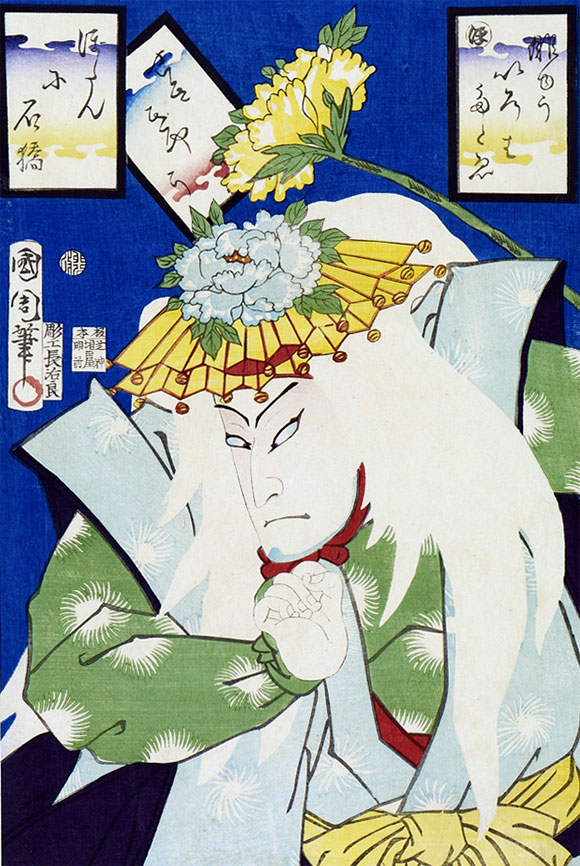| SHAKKYŌ |
| Dance title | Shakkyō |
| Author | Kineya Rokuzaemon X (music) |
| History |
The Nagauta-based song "Shakkyō" was created by Kineya Rokuzaemon X in 1820. |
| Key words |
Jakushō Monju Bosatsu Nagauta Seiryōzan Shakkyō Shakkyō (Nō) Shakkyōmono Shishi Shishimono Shosagoto Yamabushi |
| Summary |
"Shakkyō" means "stone bridge" - in particular the stone bridge which is near the summit of Mount Seiryō in China. This has been a place of pilgrimage from the earliest times since it is said to lead to the paradise of Monju, the Buddhist deity of spiritual wisdom. Monju is often depicted sitting on an attendant lion, and these lions, or "shishi", guard the stone bridge which leads to his dwelling place. A high-ranking priest named Jakushō is on a pilgrimage to Mount Seiryō - somewhere he has longed to visit for many years. He can see the distant stone bridge, but decides to rest before attempting to cross it. A local woodsman and a young boy come along, and Jakushō summons them to him in order to question them about the stone bridge. He has devoted his life to the Buddha, he says, and wishes to cross it to reach the Pure Land of Monju on the far side. His new companions instruct him to wait, since even the holiest need to practise many severe religious austerities over a period of weeks or even months before attempting the perilous crossing. The bridge has been there since the first creation. It is a miracle, and not a man-made structure. It is extremely narrow, but spans a very great distance, and furthermore it is covered in moss, and offers no secure footholds. Additionally, it is guarded by shishi lions, and the ravine below it is almost bottomless, whilst above it the mountain peak rises into the clouds. Monju's paradise is indeed on the other side of it, but it was not made for mere mortals to cross. Jakushō falls into a deep sleep, and has a vision which reveals that the young boy he has met is in reality the bodhisattva Monju himself. When he wakes up, he is filled with gratitude for his vision, worships the holy bodhisattva and departs to pray. A comic local villager enters. He is on the lookout for pilgrims - and sure enough a yamabushi priest duly appears. He informs the villager that he has come to cross the stone bridge, but that he is anxious about the shishi lions that he has heard are its guardians. The villager acknowledges that the shishi are very fierce, and if anyone who is lacking in ascetic practice attempts to cross the bridge they will be devoured in a single gulp. The yamabushi is scared, but refuses to turn back, saying that if he recites his special prayers he is certain to be protected. But the prayer he then utters is just nonsense, and when the mountain rumbles the pair think that the shishi are about to appear, and run off as fast as they can. There is a great wind in the mountains, and following a musical interlude the young boy and the woodsman reappear, but this time in their true forms as the bodhisattva Monju, who enters first via the suppon stage lift, and his attendant shishi lion, whose entrance follows along the hanamichi. They are followed by a group of young men, whose dancing and acrobatics serve to emphasise the power and majesty of Monju and his shishi attendant. The shishi is teased into a state of frenzy which emphasises his fierce grandeur, and his rousing dance is seen as being auspicious. The deity Monju takes his seat on the lion throne at the conclusion of the play. Summary written by Marion Hudson (2015) |
 |
|
Nakamura Shikan IV performing in a shakkyōmono in a print made by Toyohara Kunichika |
|
|
| Contact | Main | Top | Updates | Actors | Plays | Playwrights | Programs | Links | FAQ | Glossary | Chronology | Illustrations | Prints | Characters | Derivatives | Theaters | Coming soon | News |